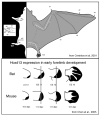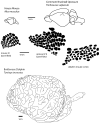In search of a unifying theory of complex brain evolution
- PMID: 19338502
- PMCID: PMC2666944
- DOI: 10.1111/j.1749-6632.2009.04421.x
In search of a unifying theory of complex brain evolution
Abstract
The neocortex is the part of the brain that is involved in perception, cognition, and volitional motor control. In mammals it is a highly dynamic structure that has been dramatically altered in different lineages, and these alterations account for the remarkable variations in behavior that species exhibit. When we consider how this structure changes and becomes more complex in some mammals such as humans, we must also consider how the alterations that occur at macro levels of organization, such as the level of the individual and social system, as well as micro levels of organization, such as the level of neurons, synapses and molecules, impact the neocortex. It is also important to consider the constraints imposed on the evolution of the neocortex. Observations of highly conserved features of cortical organization that all mammals share, as well as the convergent evolution of similar features of organization, indicate that the constraints imposed on the neocortex are pervasive and restrict the avenues along which evolution can proceed. Although both genes and the laws of physics place formidable constraints on the evolution of all animals, humans have evolved a number of mechanisms that allow them to loosen these constraints and often alter the course of their own evolution. While this cortical plasticity is a defining feature of mammalian neocortex, it appears to be exaggerated in humans and could be considered a unique derivation of our species.
Figures
References
-
- Armentano M, Chou SJ, Srubek Tomassy G, Leingartner A, O'Leary DD, Studer M. COUP-TFI regulates the balance of cortical patterning between frontal/motor and sensory areas. Nat Neurosci. 2007;10:1277–1286. - PubMed
-
- Asanuma C, Stanfield BB. Induction of somatic sensory inputs to the lateral geniuclate nucleus in congenitally blind mice and in phenotypically normal mice. Neuroscience. 1990;39:533–569. - PubMed
-
- Bassett DS, Bullmore E. Small-world brain networks. Neuroscientist. 2006;12:512–523. - PubMed
-
- Bishop K, Goudreau G, O'Leary D. Science. New York, NY: 2000. Emx2 and Pax6 regulate area identity in the mammalian neocortex. in press. - PubMed
-
- Boncinelli E, Gulisano M, Spada F, Broccoli V. Emx and Otx gene expression in the developing mouse brain. Ciba Foundation Symposium. 1995;193:100–116. - PubMed
Publication types
MeSH terms
Grants and funding
LinkOut - more resources
Full Text Sources










